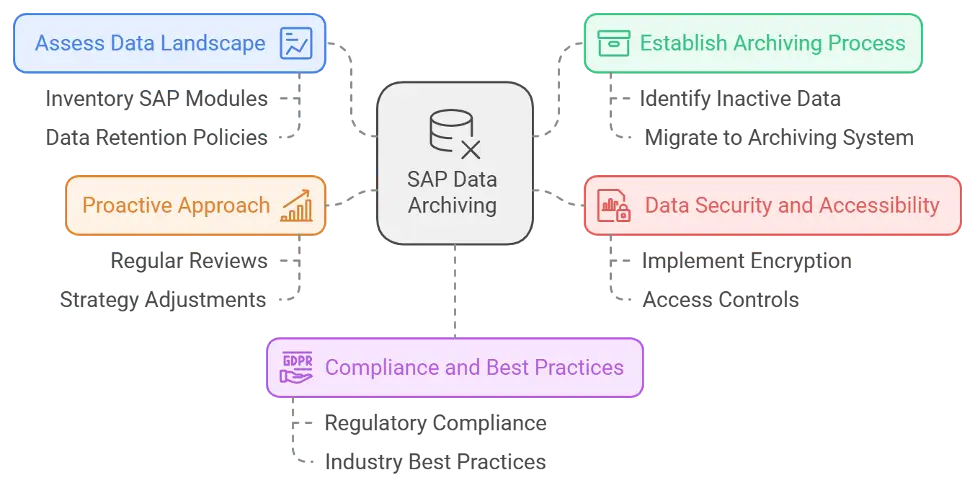How to archive your SAP data for long-term storage?
Listen to this blog

As businesses continue to generate ever-increasing volumes of data, the challenge of managing and archiving that information has become a critical priority. For companies relying on SAP as their enterprise resource planning (ERP) system, this issue takes on heightened importance. After all, SAP houses a treasure trove of sensitive and mission-critical data – from financial records to inventory levels and beyond. Failing to properly archive this information could spell disaster down the line.
Fortunately, there are proven strategies for archiving your SAP data for long-term storage. By following best practices, you can ensure your crucial information remains secure, accessible, and compliant with relevant regulations. In this article, we’ll break down the key steps to implement an effective SAP data archiving solution.

Assess Your Data Landscape
The first – and perhaps most important – step is to thoroughly assess your current data landscape. Take stock of the various SAP modules and applications in use across your organization, as well as the specific data types and volumes associated with each. This will provide a clear picture of the scope and scale of your archiving needs.
It’s also crucial to understand your company’s data retention policies and any governing compliance requirements. Knowing precisely how long you’re obligated to maintain different categories of information will inform your archiving strategy and timeline.
Establish a Robust Archiving Process
With a comprehensive understanding of your data in hand, you can begin to put an archiving process into place. This typically involves identifying data that is no longer actively used but must be retained, then systematically migrating that information to a dedicated archiving system or solution.
Many SAP customers opt to leverage the platform’s own archiving tools, which facilitate the secure and compliant transfer of data. Alternatively, there are third-party archiving platforms designed to seamlessly integrate with SAP environments – like Solix’s Cloud Data Management for SAP | SOLIXCloud. Whichever approach you choose, the key is to ensure a streamlined, automated archiving workflow that minimizes disruption to day-to-day business operations.
Prioritize Data Security and Accessibility
As you archive your SAP data, it’s critical to maintain the highest standards of security and accessibility. After all, this information remains mission-critical – you need to be able to quickly retrieve and reference it as needed, while also protecting it from unauthorized access or tampering.
Leading archiving solutions typically incorporate robust encryption, access controls, and audit logging capabilities to safeguard your data. Additionally, many offer advanced search and retrieval functions, allowing you to locate and extract specific information with ease. By prioritizing both security and usability, you can have peace of mind that your archived data remains safe, compliant, and readily available.
Maintain a Proactive Approach
Archiving your SAP data is not a one-time event, but rather an ongoing process that requires continuous monitoring and optimization. As your business grows and evolves, your data landscape will inevitably change – necessitating regular reviews of your archiving strategy and adjustments as needed.
Make it a point to routinely assess your archiving practices, identify opportunities for improvement, and implement updates accordingly. This proactive approach will ensure your SAP data remains properly managed and protected for the long haul, even as your organization’s needs and requirements shift over time.
Solix has a Solution
SOLIXCloud SAP active archiving (Active SAP Data Archiving | SOLIXCloud) helps identify and move infrequently accessed data from production SAP systems on a regular basis to low-cost cloud storage while keeping the data readily accessible for reporting, analysis and regulatory compliance. This ongoing process helps organizations reduce the size and complexity of their production systems, leading to improved system performance, reduced software and infrastructure costs, and better compliance with data retention policies.
In an era defined by exponential data growth, the importance of effective SAP data archiving cannot be overstated. By following the steps outlined above, you can establish a robust, compliant, and future-proof archiving solution that safeguards your critical information while keeping it readily accessible. Invest in your data archiving strategy today, and reap the benefits for years to come.
Stephen Tallant
As the Director of Product Marketing at Solix Technologies, I lead the development and communication of the product and solution story to the market. I have over 25 years of experience in product marketing and product management, creating engaging messaging, launch plans, collateral, and content for various software solutions. I live in metro Philadelphia, and am a big sports fan - so much so, I sit on the Board of the Philadelphia Sports Hall of Fame. I attended Villanova University for both my undergraduate and graduate degrees.
